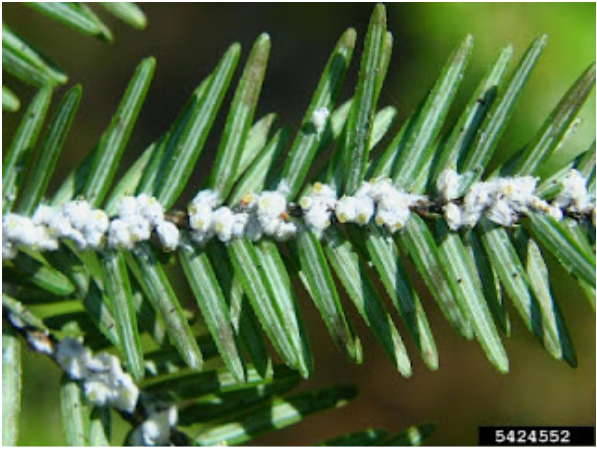New Insects: Hemlock Woolly Adelgid and Elongate Hemlock Scale
Two introduced insects are significantly impacting our state tree’s growth and survival, hemlock wooly adelgid and elongate hemlock scale. Hemlock woolly adelgid (HWA, Adelges tsugae) is an aphid-like insect, native to Asia. HWA feed on tree sap by inserting their mouthparts at the base of the needles and removing plant fluids. Their feeding causes the needles to turn gray, die, and drop from the tree.
Elongate hemlock scale (EHS, Fiornia externa) is another non-native insect originally from Japan that is attacking hemlocks. Like HWA, EHS is a sap feeder, causing tree decline and mortality. Feeding injury causes needles to develop a yellow banded appearance. This causes needles to drop, giving crowns of infested trees a thin appearance.
How to Identify HWA
To identify HWA, look for the masses of woolly white filaments on the underside of twigs at the base of the needles. The masses are produced by the females (there are no males) and are about 2 millimeters long. The white, woolly masses conceal overwintering females and their eggs.
How to Identify EHS
To identify EHS, look for this wax-covered insect on the underside of needles. The flattened, elongate, light yellow-brown to brownish-orange waxy cover of the adult female is about 1.5 millimeters long. Males have a smaller, white, waxy cover. Sometimes waxy secretions from settled crawlers may build into a mass of tangled strands. When EHS are abundant, their white waxy strands can be confused with HWA.
Decline in Hemlocks
Under the right conditions, both insects can cause severe decline and even kill hemlock trees in as few as four years. Cold, hard winters lower the insects survival rate. But with the milder winters we’ve experienced due to climate change, we will likely see these insects continue to expand throughout the hemlock’s range.
While much has already been written about these pests, we felt an update was in order since we continue to see infested hemlocks that are in dire need of treatment. If you are not sure what to look for contact us at Cutting Edge and one of our Arborist Representatives can visit your property for free and examine your trees. There are also numerous online resources from university Extension services as well as state natural resource agencies that can help you identify infested trees.
What else you can do
- Keep hemlocks healthy by reducing disturbance to the root zone, mulching properly, and watering during periods of dry weather.
- Inspect trees regularly, before the insects have a chance to spread and cause tree decline. Some infestations may be hard to identify high in the canopy. Be sure to look at branches that break out after storms or have Cutting Edge collect samples using a pole pruning saw.
- If either of the insects are identified, have an arborist from Cutting Edge provide you with a treatment plan. Many treatment options are available, some lasting as long as four years. NOTE: We do not recommend treating trees preventatively. If the insects are not found, no treatment is necessary.
Should we still be planting hemlocks? Yes, just be aware that treatment for these insect pests will likely be necessary. Researchers continue to look at biological controls, such as insects that feed on adelgids, as well as developing resistant hemlock varieties. However, the results of this research is not likely to be available any time soon.
If the thought of continuously treating hemlocks for these pests is not appealing, many native conifers are available that can be planted as a substitute. They include fir (balsam, frasier, and white), spruce (white and red), white pine, and northern white cedar (Arborvitae). Some recommend planting Norway spruce, although it is not a native tree.
Help save our hemlocks and stop the spread of these two invasive insects. Examine your hemlocks or ask a qualified arborist to do so. If the insects are discovered, take responsibility and have your trees treated so you don’t contribute to the decline of our native hemlocks and the continued spread of these insects. It is up to each of us to do our part to protect our state tree.

